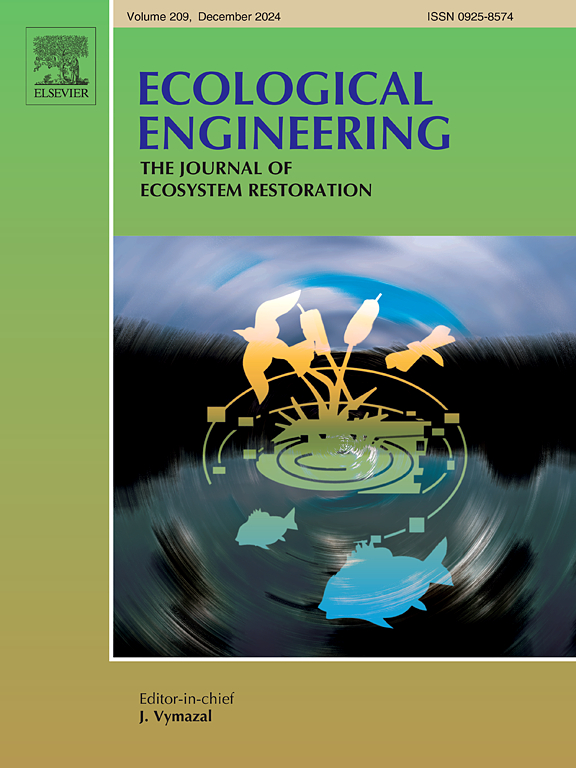Particle tracking to assess safe fish transport through closed conduit components
IF 3.9
2区 环境科学与生态学
Q1 ECOLOGY
引用次数: 0
Abstract
Fish travelling through closed conduit systems experience a range of hydrodynamic effects which can influence fish wellbeing and consequently ecological restoration and conservation outcomes. Computational Fluid Dynamic (CFD) models are a promising tool for assessing such effects to improve fish safety. In this study, Lagrangian sensors were used in a physical model, systematically testing hydrodynamic conditions in pipe components in conjunction with live fish tests of Australian silver perch (Bidyanus bidyanus) to determine safe fish transport thresholds and fish travel paths. CFD models of pipe components were validated using the Lagrangian sensor data and Discrete Phase Model (DPM) particles with good agreement of pressure and acceleration data. The implementation of a simple active particle function to represent fish movement greatly improved the particle paths in the model, matching trajectories of live fish transported through the pipe components. Utilising active paths, the CFD models identified additional hydrodynamic threshold values to prevent fish injury. CFD modelling of larger pipes suggested that closed conduit fish passage through full-scale pipes present similar risk to laboratory-scale tests. These findings show that CFD models will assist the sustainable design of closed conduit fishways, which can improve river connectivity.
颗粒跟踪评估通过封闭管道组件的鱼类安全运输
通过封闭管道系统的鱼类会经历一系列的水动力效应,影响鱼类的健康,从而影响生态恢复和保护的结果。计算流体动力学(CFD)模型是评估这些影响以提高鱼类安全的一个很有前途的工具。本研究在物理模型中使用拉格朗日传感器,结合澳大利亚银鲈(Bidyanus Bidyanus)活鱼试验,系统地测试管道部件的水动力条件,以确定鱼类的安全运输阈值和鱼类的旅行路径。利用拉格朗日传感器数据和离散相模型(DPM)颗粒验证了管道部件的CFD模型,其压力和加速度数据具有良好的一致性。实现一个简单的主动粒子函数来表示鱼的运动,极大地改善了模型中的粒子路径,匹配了活鱼通过管道部件运输的轨迹。利用主动路径,CFD模型确定了额外的水动力阈值,以防止鱼类受伤。较大管道的CFD模型表明,封闭管道鱼通过全尺寸管道的风险与实验室规模测试相似。这些结果表明,CFD模型将有助于封闭式管道鱼道的可持续设计,从而改善河流的连通性。
本文章由计算机程序翻译,如有差异,请以英文原文为准。
求助全文
约1分钟内获得全文
求助全文
来源期刊

Ecological Engineering
环境科学-工程:环境
CiteScore
8.00
自引率
5.30%
发文量
293
审稿时长
57 days
期刊介绍:
Ecological engineering has been defined as the design of ecosystems for the mutual benefit of humans and nature. The journal is meant for ecologists who, because of their research interests or occupation, are involved in designing, monitoring, or restoring ecosystems, and can serve as a bridge between ecologists and engineers.
Specific topics covered in the journal include: habitat reconstruction; ecotechnology; synthetic ecology; bioengineering; restoration ecology; ecology conservation; ecosystem rehabilitation; stream and river restoration; reclamation ecology; non-renewable resource conservation. Descriptions of specific applications of ecological engineering are acceptable only when situated within context of adding novelty to current research and emphasizing ecosystem restoration. We do not accept purely descriptive reports on ecosystem structures (such as vegetation surveys), purely physical assessment of materials that can be used for ecological restoration, small-model studies carried out in the laboratory or greenhouse with artificial (waste)water or crop studies, or case studies on conventional wastewater treatment and eutrophication that do not offer an ecosystem restoration approach within the paper.
 求助内容:
求助内容: 应助结果提醒方式:
应助结果提醒方式:


